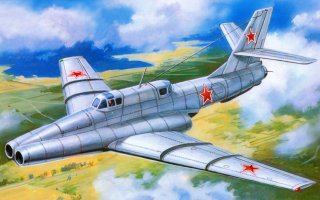Russia's Il-40 Ground Attack Jet Was Perfect—Except for One Fatal Flaw
The shortcoming lay with the jet's auto cannons.
Here's What You Need to Know: Good pilot visibility, good protection, and decent maneuverability weren’t enough to overcome a fatal flaw.
After the Second World War, a huge number of radical and experimental aircraft were built by the various victorious powers. Ushered in by the jet age, or aircraft that could safely and reliably fly faster than the speed of sound, the Soviet Union and the United States in particular built and tested some wild airplanes.
The challenges the jet age presented were myriad: jet engine development advanced by leaps and bounds, though the airframe design sometimes struggled to keep pace. In particular, transitioning from subsonic to supersonic speeds meant that early airframe designs were optimized for Mach 1+ speeds, but could be unwieldy at flight speed below the speed of sound.
Difficulties aside, the legendary Soviet state-owned aerospace company Ilyushin decided to tackle the problem of fitting jet engines to a ground support attack plane. And, in the Ilyushin Il-40, believed it had a winning design.
The Il-40 was in some ways a classic ground-attack airframe design. The two-man crew, both pilot and gunner, were protected inside the airframe by an armored pod. In addition to protecting from ground fire, the cockpit glass was also armored, as was the pilot’s seat back and headrest. Sitting on top of the airframe, the pilot had an excellent vantage point.
For the time, the Il-40 had a relatively standard weapon loadout. The wings had four small integrated bomb bays that could each carry a small free-fall bomb, as well as an additional four bomb racks on the wing undersides that could carry drop tanks for extra fuel, unguided rockets, or additional unguided bombs.
In addition, the Il-40 had six 23-millimeter autocannons mounted to the airframe’s nose. And therein was the Il-40’s major shortcoming.
Firing six, large 23-mm auto cannons simultaneously produced a prodigious amount of blast gasses. And their forward position at the Il-40’s nose meant that expended gas immediately rushed back along the fuselage and into the airplane’s jet engine air intakes.
Rather than sucking in and compressing air to create combustion inside the engines, and therefore thrust, the Il-40 got a mouthful of dead blast gas anytime the pilot engaged the six 23mm autocannons.
Blast gas ingestion resulted in engine flameout. Compounding the problem, the plane’s autocannons were so far forward that pilots experienced brief blindness thanks to the six outsized muzzle flashes.
Postscript
Several different gun configurations were proposed in order to remedy the engine flameout problem. One of them saw the Il-40’s guns belly-mounted, and greatly extended engine air intakes into the airframe nose, giving the ground attack plane a distinct double-barreled shotgun look. Ultimately, the redesigns were unsuccessful, and the Il-40 never entered serial production.
Caleb Larson is a defense writer for the National Interest. He holds a Master of Public Policy and covers U.S. and Russian security, European defense issues, and German politics and culture.
This article first appeared in November 2020.
Image: Pinterest

